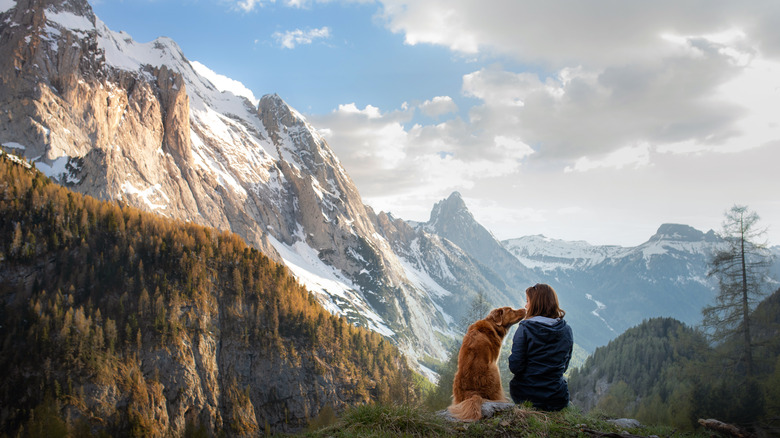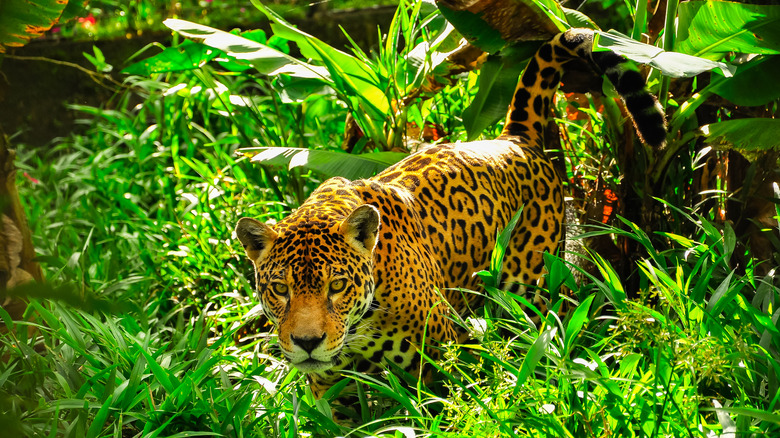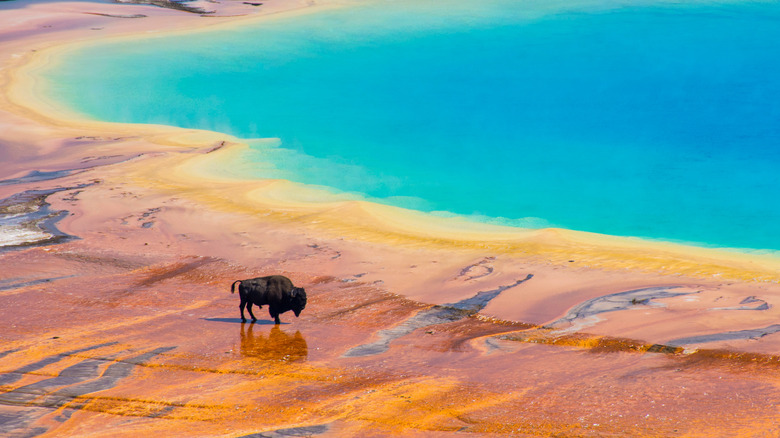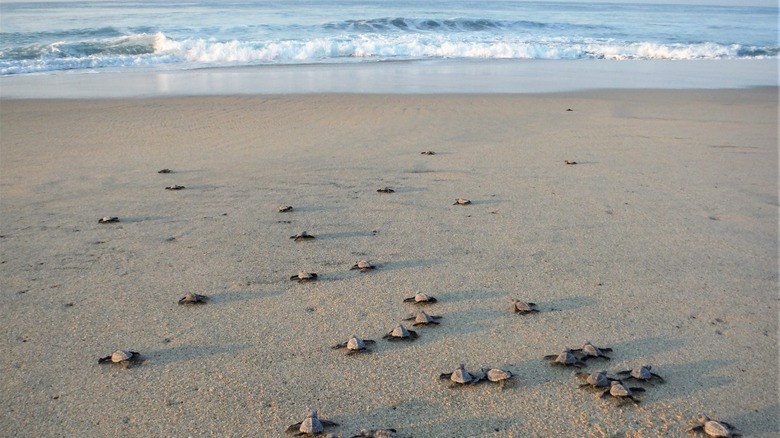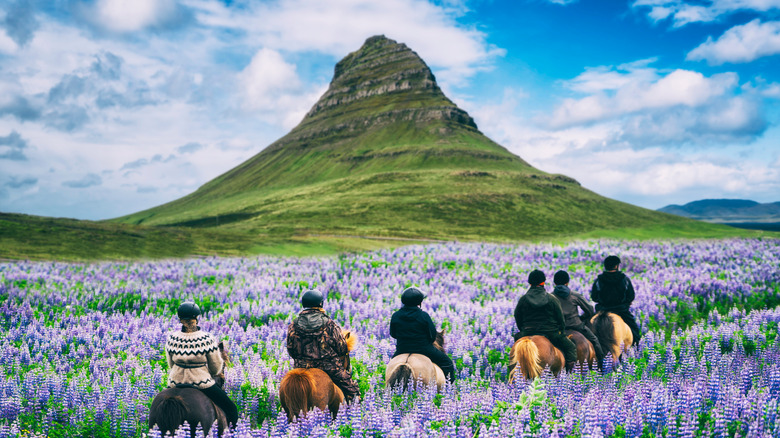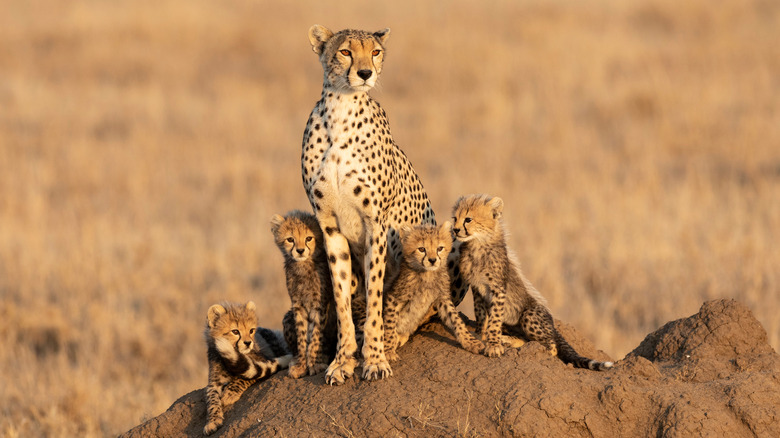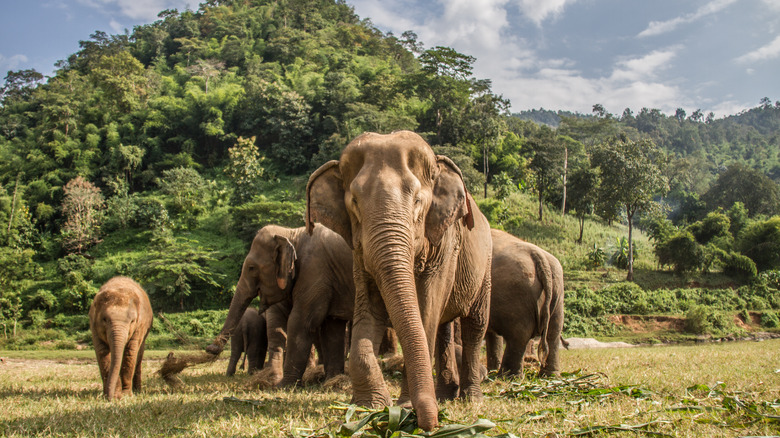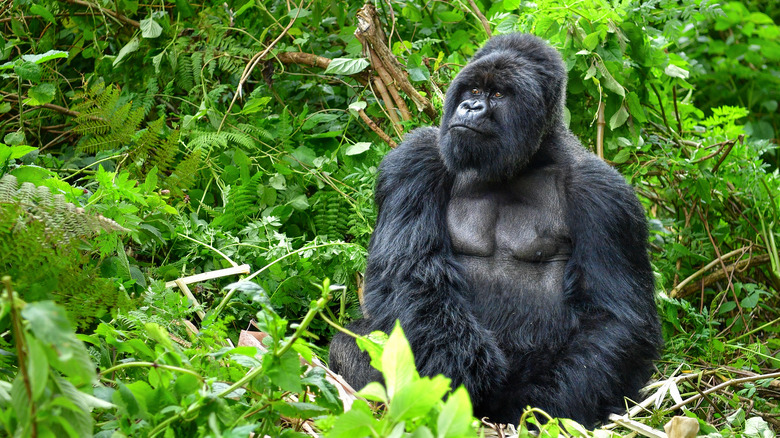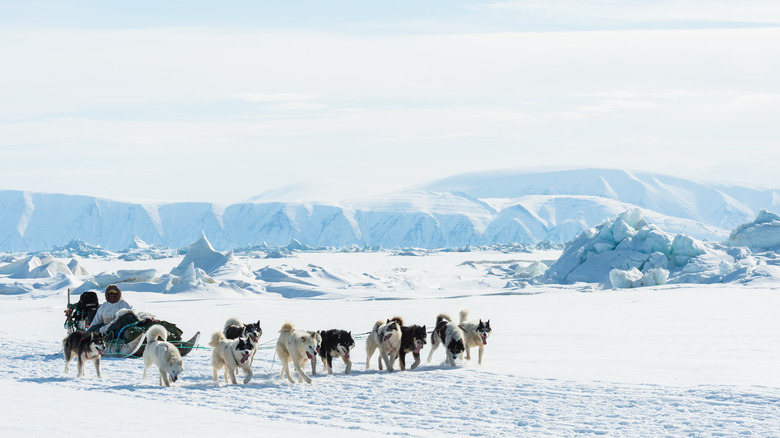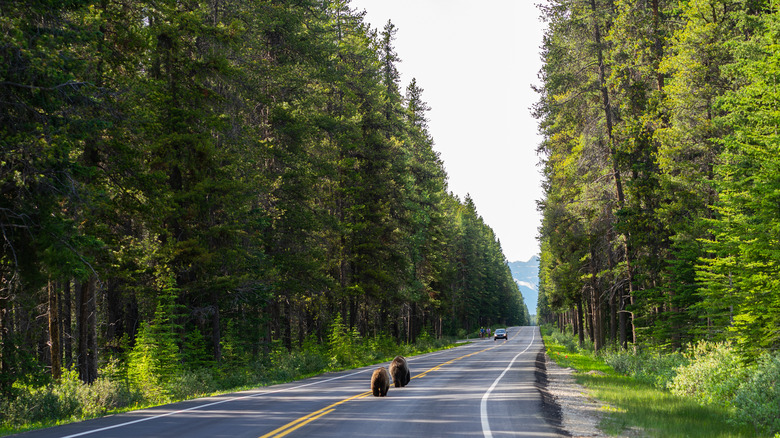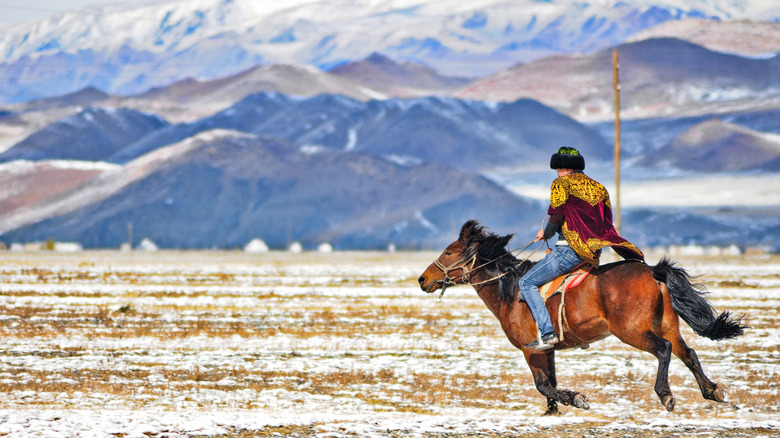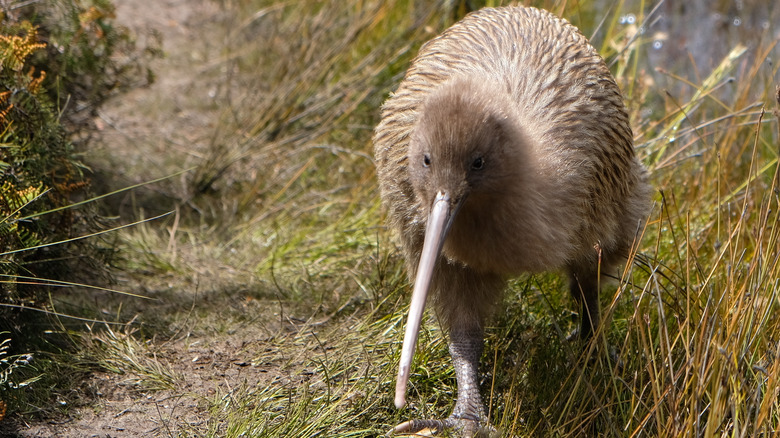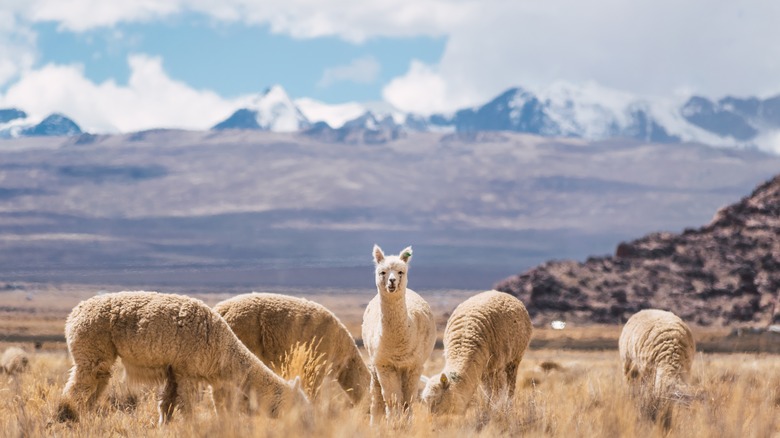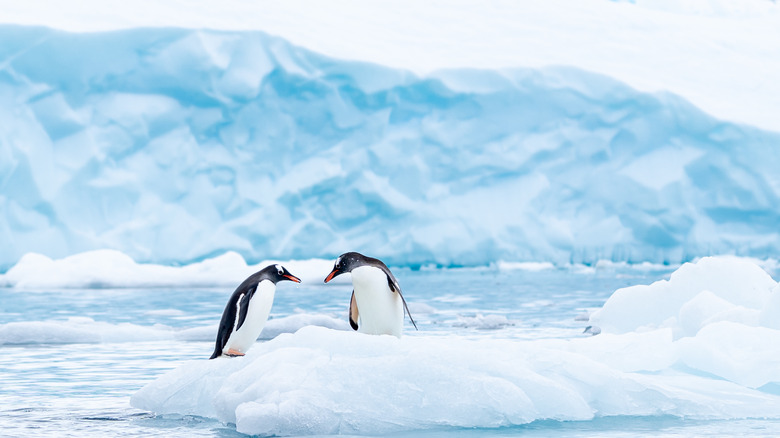Travel Destinations For People Who Are Obsessed With Animals
So, you're an animal person ready to book your next vacation but aren't quite sure where to go. That's understandable, the world is so big, and it's quite overwhelming when you try to pick a destination. Luckily, we've researched 13 of the best vacation destinations for animal lovers. The planet is so diverse, you're spoiled with choices when it comes to visiting Earth's furry and feathered friends. From the jungles and mountains of South America to the steppes of Central Asia and even closer to our backyard in the U.S.
Remember, we want to travel better in the decades to come. That means being responsible and not contributing to harmful practices, particularly when it comes to wildlife and nature. That's why this article focuses on national parks, sanctuaries, and conservation efforts and omits zoos and anything near the Tiger King category. If you opt to go somewhere not listed, make sure you look for red flags like small enclosures or unnatural living spaces, experiences that involve close contact with wild animals, or profiting from them in any fashion.
Hang with jaguars, capybaras, and more at Emas National Park, Brazil
The Southern American country may be known primarily for the Amazon and its resident monkeys, but in the central part of western Brazil lies Emas National Park. Home to pumas, ocelots, tapirs, capybaras, and numerous monkey species, including the famous howlers. Remember, monkeys and other animals may look cute and cuddly, BUT they are still wild animals and should be treated as such, so keep your distance and don't feed them!
Emas is still a lesser-known destination and animal lovers will enjoy the large jaguar population, which has had to fight with farmers for land rights in recent years in the Cerrado region where the park is located. However, according to a piece published in Scientific American, in recent years farmers have pushed for the species' return, to help curb the wild pig population that decimates crops. Additionally, there are fears of extinction if more isn't done to protect the jaguar's environment. Cat corridors that help facilitate safe movement through human-occupied areas have been recommended by numerous wildlife groups, per nonprofit Mongabay's news site. This demonstrates how fragile ecosystems are and how we need to work together. The best way to see any of these famous species is to book a tour. This will also ensure your safety as well as that of the animals.
Explore wants to acknowledge that this is the traditional territory of the Xavante.
View North America's most iconic wildlife in Yellowstone National Park
Yellowstone has long been one of the most visited national parks in the U.S., even before the premiere of the hit show set in the area, which spans three states (Idaho, Montana, and Wyoming.) And while the rainbow hot springs, cascading waterfalls, and high peaks would delight even the most apprehensive potential outdoors-goer, the main reason people flock to the park is the promise of wild animals. Home to grizzly and black bears, cougars, (recently introduced) wolves, wolverines, and bobcats, large mammals reign supreme in this part of pristine wilderness.
Additionally, numerous birds like bald eagles and mountain bluebirds can be spotted in the trees and skies. If you're more of an aquatics person, numerous species of lizards, frogs, and fish call Yellowstone home. And of course, we can't forget the iconic bison, which frequently cause traffic jams on roads all over the region. Remember though, the best way to view these amazing creatures is from a distance, if one wanders into a road, campsite, or hiking trail, follow safety precautions from the rangers. If you'd like to find out more about the park's initiatives to protect all the species that call it home, check out Yellowstone Forever.
Explore wants to acknowledge that this is the traditional territory of the Blackfeet, Cheyenne, Coeur d'Alene, Comanche, Colville Reservation, Crow, Eastern Shoshone, Gros Ventre and Assiniboine, Kiowa, Little Shell Chippewa, Nez Perce, Northern Arapaho, Northern Cheyenne, Salish and Kootenai, Shoshone–Bannock, Sisseton Wahpeton, Spirit Lake, Turtle Mountain Band of the Chippewa, Umatilla Reservation, and Sioux People.
Learn about baby turtle protection in Mexico
Numerous species of turtles are found throughout Mexico. The Yucatán Peninsula is home to green turtles and loggerheads, the area around Puerto Vallarta has olive ridley, and the Baja Peninsula has green turtles and leatherbacks (one of the largest reptiles on earth). And one of the best parts of having these species all over the country is the season from May to October when the new crop of babies hatch and make their way to the ocean. Anyone who has a love for living creatures will love to combine a beach trip with a baby turtle spotting expedition.
But remember, turtles are a protected species, and while people might tell you where you can find them in the wild (on local beaches), you should treat them with respect for their safety and survival. So, if you happen across a nest on a beach, observe from a distance and hopefully, this goes without saying, but do not attempt to catch them! However, it's not recommended to deliberately go out searching for them. The best and most ethical way to see them is at a sanctuary. Try the Xcacel Turtle Sanctuary, or the Palmarito Sea Turtle Project.
Explore wants to acknowledge that this is the traditional territory of the Aztatlan, Cochimí, Huichols (Wixárika), Guaycuras, Maya, and the Pericú.
Ride Icelandic horses in their homeland
Having grown in popularity over the past couple of decades, Iceland is not exactly a hidden gem anymore. However, that doesn't mean it's not worth visiting, especially if you love animals, as it's home to an iconic equine — the Icelandic Horse. According to the International Museum of the Horse, the species dates back to the 9th Century when Vikings settled the area and brought horses with them. Due to the Nordic island nation's isolation, the horse developed without much input from other breeds and is now known for its unique characteristics, including distinctive five gaits. The breed benefits from this isolation even today and remains vaccine and disease free. This is also why should you book a riding tour, you'll need to use gear from the Icelandic stables, as they don't allow anything from abroad to come into contact with the horses, for fear of outbreaks.
The horse is extremely important in Icelandic life and features prominently in Icelandic Sagas and in Norse mythology. The country is home to over 80,000 horses, but the breed has also gained popularity abroad, and 100,000 Icelandic Horses can be found in destinations as far away as New Zealand and Hawaii, according to Horses of Iceland. If you want to meet these Icelandic symbols or go for a ride, book a tour.
Take a safari in Tanzania
There are numerous places to see lions, cheetahs, and wildebeest (oh my!) beyond the famous Serengeti. From the Ngorongoro Crater to the Mahale Mountains and Lake Manyara, a trip to Tanzania won't disappoint anyone fond of wildlife. The best part about a trip to this eastern African country is that it's truly a year-round destination. Both in the sense of weather, which is generally pleasant in every season, and wildlife viewing, which is possible in every month of the year, per Go 2 Africa. However, summer is the best spotting season as animals tend to congregate around watering holes.
Additionally, if you have time beyond just a traditional safari, you can enjoy even more animal-centric experiences. From chimpanzee trekking in Mahale and Gombe rainforests to wildebeest migration viewings and hiking Mount Kilimanjaro. Per the Blonde Abroad, wildebeest and zebra migrations, which are unforgettable things to view, happen in June and July.
View elephants ethically at an elephant sanctuary in Thailand
An elephant's story is not always a happy one, due to poaching and cruel elephant tourism. In Thailand, experiences around elephants aren't always ethical and the history is more than just a bit problematic. However, that doesn't mean animal lovers (or anyone for that matter) should discount the country entirely. There are ethical ways to appreciate the gentle giants and a sanctuary is a great place to start. How do you know if a sanctuary is truly looking out for the best interest of the elephants? According to Peta, a true sanctuary will never give elephant rides or force the animals, (who naturally avoid humans) into any situation that involves close contact. This means elephant shows, baths, or swims of any kind are red flags. Additionally, good signs are places that provide a large expansive space for elephants to socialize with other elephants, as they would in the wild.
If you would like to donate your time as an elephant enthusiast, there are ways to do so without contributing to the problem. Look for sanctuaries that provide volunteer opportunities that don't involve any close contact with the animals. This includes cleaning the elephant areas and preparing feed (when they aren't present) as is done at the Burm and Emily Elephant Sanctuary in Chiang Mai. Or planting trees and composting to help with reforestation, like at the Phuket Elephant Sanctuary, which strictly advertises hands-off volunteering.
Go gorilla trekking in Rwanda
The African continent is most famous for safaris when it comes to animal vacations, but you likely won't see our closest cousin, the gorilla, on one. If that's something on your bucket list, head to Rwanda and lace up your hiking boots for a much more active trip! A gorilla trek is a fantastic way to see not only these amazingly intelligent creatures but also the beautiful country that they inhabit. The species here are the endangered mountain gorilla (who also lives in Uganda and the Democratic Republic of the Congo) and, according to Visit Rwanda, only about 1,000 are left in the wild. Many of them live in the Volcanoes National Park in Rwanda—where your trek is likely to take place.
The government closely controls how many trekkers head into the park in search of the families of gorillas by limiting the number of permits issued each day. In order to go in the mountains, you'll need to go with an approved guide, with hikes lasting between 30 minutes and all-day (visitors are split up according to fitness level), per Visit Rwanda.
Go dogsledding in Greenland
Even if you aren't part of the generation that grew up on Balto, dogsledding is an unforgettable winter adventure full of history. And for those of us who love our furry friends, it's also the ultimate vacation activity. What is the best place to do this? Greenland of course, where it's a part of the culture and way of life for locals. And according to Visit Greeland, dogsledding is one of the best ways to see the country due to the historic connection and slower pace, especially when compared to snowmobiles.
Like the Icelandic horse, the Greenlandic sled dog is a pure breed that is specially bred for the climate and conditions of the region, and of course to pull dog sleds. Thus, they're protected like their nordic equine cousins, and per Greenland by Topas, it's forbidden to introduce any other breed to the area. Normally a winter activity, the best months for this particular activity are January through March. And coincidentally, those months are also the best chance to view the Northern Lights, another amazing Arctic experience.
Hangout with the wildlife in Banff National Park, Canada
Canada's most popular park is best known for picture-perfect lakes like Louise and Moraine — what many visitors to our northern neighbor envision the entire country to look like. The main reason this park is so popular is the abundance of wildlife. From elk to bighorn sheep to grizzlies and numerous birds, you'll be spoiled for choice in this beautiful section of the continent.
According to Banff and Beyond, the best time of day to see the animals is dawn and dusk. So enjoy a day of hiking, skiing, or snowshoeing (depending on the time of year you visit) and then grab your camera, jump in the car and slowly drive with alert eyes. Also, remember the time of year you visit can impact what you see. Bears hibernate from late fall to early spring and baby elk are born in late spring and early summer, per Banff Lake Louise. The park also has numerous bridges and tunnels, which wildlife use as over (or under) passes to safely cross roads throughout the park. Remember, while the animals (particularly the baby ones) are extremely cute, they're not domesticated. Keep your distance, never feed them, lock up all trash, drive slowly, and keep dogs leashed (from Parks Canada). Banff also provides wildlife safaris, should you want to explore with an expert.
Explore wants to acknowledge that this is the traditional territory of the Iyârhe Nakoda Nations, the Blackfoot, the Tsuut'ina, Ktunaxa, Secwépemc, Mountain Cree, and Métis People.
Trek through history with horses in Mongolia
Horse trekking has a long history in Mongolia, as the Mongolian horse dates back nearly 6,000 years and nearly became extinct in the 1960s per Stepperiders. Luckily, breeding programs abroad allowed for the reintroduction of these national symbols and you can now see many wild Mongolian horses in Hustai National Park.
The Mongols and Genghis Kahn are of course the most Mongolian horse trekkers and while you'll no longer (thankfully) see bloody pillages like that roaming the plains, you can enjoy the way of life on horseback. Many of the horses might be wild, but some have been domesticated and are ridden by locals who often learn from an early age, with about 30% of the population is considered nomadic, according to The Travel. Treks can last a couple of days to a couple of weeks and accommodation is typically in traditional yurts. Remember, summer is the best weather and thus, the main season most tour operators offer these excursions.
Spot Kiwi birds on Kapiti Island, New Zealand
Kiwis may be what New Zealand residents are commonly called, but the name actually refers to native flightless birds that look like adorably shaggy, long-beaked kiwi fruit. These funny-looking creatures are a must-see on any visit to Aotearoa (the Māori name for the two islands that make up New Zealand). And, you may not know there are actually five species of the national icon, of various sizes and colors according to the Department of Conservation. However, unfortunately, in the past few centuries, the population has dwindled from the millions to less than 70,000, according to Save the Kiwi.
Threats to the birds include non-native predators (including our pets) brought in by colonizers and continued loss of habitat. According to Save the Kiwi, about half of the eggs don't hatch at all and the majority that is born don't make it past the six-month mark. Hope is not lost though! Many government and private efforts have been put in place to protect and nurture existing populations. This includes numerous sanctuaries, including one on Kapiti Island, a must-visit if you wish to see the adorable birds. The reserve strictly monitors visitors so make sure to book a tour in advance! Finally, if you wish to contribute to conservation efforts (beyond donating money), or at least not cause any harm, remember to drive slowly through habitats (marked by yellow signs with a Kiwi bird symbol) and leash pets.
Explore wants to acknowledge that this is the traditional territory of the Māori.
Check out llamas and alpacas in Peru
Frequently mistaken for each other, both are native to the Andes Mountains. However, who you come into contact with depends on what part of Peru you find yourself in. Alpacas' roots can be traced back to Peru, but today are found all over the continent. They're smaller than llamas, have finer hair and smaller, more upright ears, and today primarily live in the central and southern parts of the country. During the Inca period, they were considered very important animals for their meat, and wool, and as well as considered sacred, according to Peru Rail. Today, their wool is used to make scarves, blankets, gloves, and many more items to keep you warm on any trek.
Alternatively, llamas are a bit bigger than their cousins and have courser hair (they also spit more) and they have bigger, floppier ears. Since their fur isn't as soft, you're less likely to find products made out of it and they're more frequently used as pack animals. Thus, you'll most often find them in the Andes, especially at Macchu Picchu, according to Peru Hop. If you'd like to get close up and personal with either, just keep your eyes open, you'll see them. Alternatively, visit numerous farms around Peru where you can take one for a walk, or just say hi.
Explore wants to acknowledge that this is the traditional territory of the Quechua, Aymara, and Asháninka.
Hang out with penguins in Antarctica
When you picture the seventh continent, images of glaciers and (mostly) unexplored wilderness likely come to mind. However, the frozen wonderland is the perfect destination for animal lovers. It's home to numerous types of animals, including many penguin species, from Emperors to Macaroni to Chinstraps and more, you'll feel like you're in real-life "Happy Feet." While they don't fly, all types of penguins are extremely adept swimmers, averaging 7 mph speeds, with the fastest up to 22 mph, according to Smithsonian Magazine. When out of the water, you can enjoy their adorable hops and waddles on the snow.
An Antarctic cruise is a dream trip for many and in most circumstances, the only way to visit. If you'd like to view penguins in their natural habitat, it's best to book an expedition cruise with one of the numerous companies offering them. Then you can use binoculars to spot the cold-weather birds from the deck, or from excursion boats or kayaks.
